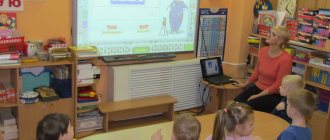Multimedia presentation as one of the forms of work using ICT in preschool educational institutions
At one of the meetings of the “Caring Parents” club, as a form of joint activity, after watching part of the cartoon, parents were asked to come up with their own ending to the story together with their child.
The fairy tales were published in the collection “Our Fairy Tales”; some of them were used in puppet shows, which were shown in the group as part of a week of theatrical activities.
In order to prevent children from visual fatigue after watching presentations, I suggest children perform a set of eye exercises. To make it more attractive, I spend them in a playful way.
Using electronic eye exercises relieves visual fatigue and improves mood.
Next, I plan to carry out work using the author’s methodology of the Honored Teacher of the Russian Federation N. M. Bolsunovsky. Game-travel “On a visit.”
The game is intended for group and individual creativity of children, as well as for joint creativity of children and parents.
Children are captivated by the bright and colorful journey that opens before them on the monitor. The game's tasks are supplemented with audio comments from the author. The game includes children's creative works: riddles, fairy tales compiled according to schemes with variations in the ending, children's poems, thoughts, impressions of the musical composition they listened to, drawings, photo compositions.
Observing my students, I can say with confidence that the knowledge acquired in kindergarten will help them be successful in school, and clear, correct speech will give them confidence.
The accumulated experience in working with ICT allows us to conclude that the use of ICT in communicative activities makes it possible to increase the efficiency of work on speech development, optimize the educational process, individualize the education of children with insufficient speech development, and also shape the success of children, increase motivation, and significantly reduce the time to master the material. .
To summarize, I will try to substantiate the main points.
The use of ICT enhances:
•positive motivation for learning;
•activates the cognitive activity of children.
The use of ICT allows educational activities to be carried out:
•at a high aesthetic and emotional level (photos, animation, music);
•provides clarity;
•attracts a large amount of didactic material;
•contributes to improving the quality of education.
Speaking of the future, I plan to master other computer programs, for example, “PervoLogo” is an open creative environment, a “computer album” designed specifically for preschoolers and primary schoolchildren. PervoLogo allows educators to fully implement the use of modern information and communication technologies as part of educational activities to teach literacy and develop speech, communication skills and creative abilities of children.
Presentation “Information technologies in kindergarten”
Faith to the Vizier
Presentation “Information technologies in kindergarten”
technical devices around him almost from birth ; they are very attractive to the child. Society lives in a world of constant multiplication of information , constant invention of devices for processing this information . A computer helps a person solve practical problems.
Slide No. 2
The “tomorrow” of today’s children is the information society . And the child must be psychologically prepared for life in the information society . Computer literacy is now becoming necessary for every person.
Therefore, a preschool educational institution, as a carrier of culture and knowledge, also cannot remain on the sidelines. We must keep up with the times and become a child’s guide to the world of new technologies .
We are talking about the use of information and communication technologies (ICT)
teachers to improve the efficiency of the educational process.
Slide No. 3
ICT means the use of a computer, the Internet, television, video, DVD, CD, multimedia, audiovisual equipment, that is, everything that can provide ample opportunities for the cognitive development of a child.
Slide No. 4
The main goal of introducing information technologies is to create a unified educational institution space, a system in which all participants in the educational process - administration, teachers, students, parents - are involved and connected the information
ICT competencies of a teacher will improve the professional level of a teacher, significantly improve the quality of education at educational institutions, and increase the prestige of the institution in the eyes of parents and the public.
Slide No. 5
Where can ICT help a teacher in his work?
The areas of application of ICT by preschool teachers are enormous.
1. Maintaining documentation.
In the preparation and execution of calendar and long-term plans, in the preparation of material for the design of the parent’s corner, in conducting diagnostics and preparing it in printed and electronic form.
An important aspect of the use of ICT is the preparation of teachers for certification. Here you can consider both the preparation of documentation and the preparation of an electronic portfolio.
2. Methodological work, teacher training.
In the information society, networked electronic resources are the most convenient, fastest and most modern way to share new methodological ideas and manuals, and your experience, regardless of where you live.
There is an opportunity to participate in various pedagogical projects, distance competitions, quizzes, olympiads, which increases the level of self-esteem of both the teacher and the students (child)
Slide No. 6-7-8
3. Educational process.
The introduction of information technologies has advantages over traditional means of teaching:
1. ICT makes it possible to expand the use of electronic learning tools, as they transmit information faster .
2. Movements, sound, animation attract children's attention for a long time and help increase their interest in the material being studied. The high dynamics of the lesson contributes to the effective assimilation of material, the development of memory, imagination, and creativity of children.
3. Provides clarity, which contributes to the perception and better memorization of material, which is very important, given the visual-figurative thinking of preschool children. In this case, three types of memory are included: visual, auditory, motor.
4. Slideshows and video clips allow you to show those moments from the surrounding world that are difficult to observe: for example, the growth of a flower, the rotation of planets around the Sun, the movement of waves, it’s raining.
5. You can also simulate life situations that are impossible or difficult to show and see in everyday life (for example, reproducing the sounds of nature; the operation of transport, etc.)
.
6. The use of information technology encourages children to search for research activities, including searching the Internet independently or together with their parents;
7. ICT is an additional opportunity to work with children with disabilities.
Slide No. 9-10
Recognizing that the computer is a new powerful tool for the development of children, it is necessary to remember the commandment “DO NO HARM!”
.
The use of ICT in preschool institutions requires careful organization of both the classes themselves and the entire regime as a whole in accordance with the age of the children and the requirements of the Sanitary Rules. (SanPiN 2.4.1.2660-10)
• Classes using a computer should be conducted with preschoolers 5-7 years old no more than 3 times a week for 10-15 minutes no more than 1 time a day. After classes, do eye exercises
•It is necessary to ensure rational organization of the workplace: furniture that matches the child’s height, a sufficient level of illumination.
• The video monitor screen should be at the child’s eye level at a distance of no closer than 50 cm.
• It is better to choose a monochromatic background for presentations that does not distract attention from the content of the slide, calm colors that do not irritate the eyesight. You can change it several times during the presentation . This will keep children's involuntary attention.
• Illustrations should be large and realistic, not overloaded with unnecessary details. It is unacceptable to use blurry photographs, as well as images that can cause fear or hostility in children.
• Don't overload your presentation with special effects . Moderate use of special effects helps to keep attention on the computer screen, increases interest, and creates a positive emotional mood, but excessive use of them leads to the opposite effect.
Today, many kindergartens are equipped with computer classes. But they are still missing:
• methods of using ICT in the educational process of preschool educational institutions;
• systematization of computer development programs;
• unified program and methodological requirements for computer classes.
Today, this is the only type of activity that is not regulated by a special educational program. Teachers have to independently study the approach and implement it in their activities.
Slide number 11
My small experience of using ICT in teaching preschoolers allows me to conclude that these are inexhaustible opportunities for the comprehensive development of a child’s personality, creativity and talent. Such activities cannot be boring or uninteresting for children, and the use of ICT further develops interest in cognitive activity.
Thus, I would like to emphasize once again that modern computer technologies allow a child to express himself and reveal his capabilities more widely within the framework of mastering educational programs.






